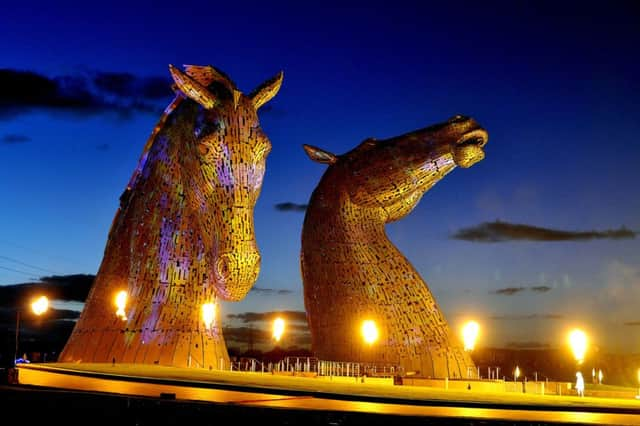Of course visitors will enjoy Scotland


IN this bumper year for Scottish tourism an important ingredient for success will be the availability of well-trained, well-informed tourist guides. This doesn’t happen by accident. The Scottish Tourist Guides Association (STGA) trains the best of Scottish guides – the Blue, Green and Yellow Badge tourist guides.
Beyond the usual Highland Games, many nature, garden, film, art, music and book festivals, as well as all our annual sporting events, 2014 is packed with special events which will attract even more visitors to Scotland. The highlights include the Glasgow Commonwealth Games, the Ryder Cup and VisitScotland’s Homecoming Scotland. In addition, anniversaries of the Great War and Bannockburn will focus attention on history. New large projects such as the Helix and the Kelpies, the Queensferry Crossing over the Forth or the V&A and Waterfront in Dundee will ensure a continuing interest in Scotland attracting visitors to this magnificent destination over the coming years.
Advertisement
Hide AdAdvertisement
Hide AdGenerating more than £4.5 billion, the Scottish tourism industry is a key contributor to the economy. The industry’s own strategic plan, Tourism Scotland 2020, led by the Scottish Tourism Alliance, is aiming at £6.6bn by the end of the decade. So how can this 2014 boom continue beyond this year? It can, but only if Scotland showcases the very best it can offer throughout this year, and invests seriously in continuing the trend.
Consistently delivering high quality, authentic experiences from before the visitor arrives to the moment of departure, is a key aim in achieving the Scotland 2020 strategy.
Of all partners within the industry, the tourist guide has the privileged insight into the visitor’s whole “journey” experience, including transport, accommodation, attractions, food, shops, infrastructure and facilities. Members of the professional association for qualified guides in Scotland, the STGA, have seen visitor expectations grow over the past half century, since its first involvement in training and accrediting courses.
Tourist guiding is not regulated in the UK. There is no need for qualifications, a certificate or even insurance to become a guide. And yet, requests for professional training and qualification through STGA courses is increasing year on year. Agents and operators of tours for all visitors – including those from cruise ships, conferences, incentive meetings, events or eco-tourism – realise that customers are increasingly sophisticated and experienced in travel matters. Visitors are seeking more rounded experiences, delivered to a high quality and involving sustainable principles.
Reflecting the active involvement of the STGA in European and world organisations, Scotland has well-structured courses for training tourist guides that are recognised throughout the world as being industry leaders. The aims of these training courses reflect one of the many aims of the STGA itself: to advance the reputation of tourist guides and to raise the standards of tourist guiding in Scotland.
In April, 19 trainee guides took the STGA exams to become Blue Badge tourist guides. This level enables guides to work throughout the whole of Scotland and takes approximately 1,300 hours of study and practice. In May, interviews for new candidates took place for the next 2014-2016 course. In June, 35 new trainees with diverse backgrounds, skills and a wide range of ages will meet as they begin to acquire background knowledge about Scotland past and present: from rocks to referendum, standing stones to stovies, Picts to pictures.
Regional studies for all areas of Scotland and professional skills for a 21st-century tourist guide are learned and practised. Participants acquire communication and presentation skills, and learn about different types of tours, customer needs, guiding scenarios, business requirements for self-employment and current visitor and industry partner expectations.
The STGA has also just delivered a course for new Green Badge tourist guides in Shetland. The Green Badge level enables guides to work in a designated region within Scotland. These regional courses also meet the recommended British and European Standard hours for tourist guide training. As with the Blue Badge, training must include at least 40 per cent practical study on a moving vehicle, walks in town and country and all manner of sites, delivered in an informative and entertaining way.
Advertisement
Hide AdAdvertisement
Hide AdIn March, 22 new Yellow Badge guides qualified too. This level is for site-specific guides, and in this particular instance was for Glasgow City Sightseeing Tours, which visitors enjoy using to get an overview of the city. More than 50 members of the STGA have also been especially trained to deliver new Sporting Heritage Tours by coach in Glasgow to coincide with the year of the XX Commonwealth Games. Guided walks through Glasgow Green also highlight sporting connections in this part of the city. Special training for these one-off events are a part of the Continuous Professional Development programme which the STGA supports.
The STGA continues to contribute quality, standards, codes of conduct and ethics for tourist guiding, enhancing memorable visits and tours for all visitors, thus ensuring that 2014 will be a truly successful year for tourism in Scotland.
• Mary Kemp Clarke is course director of the Scottish Tourist Guides Association www.stga.co.uk
SEE ALSO